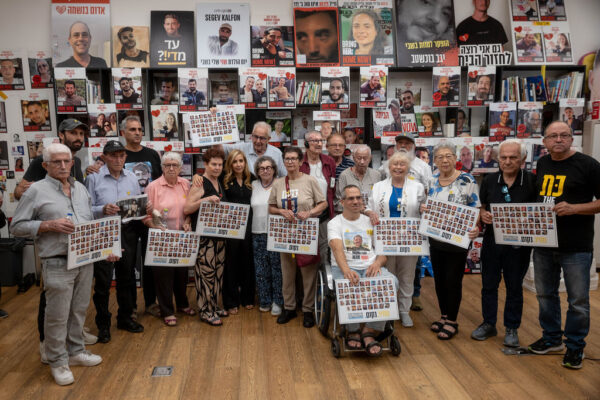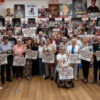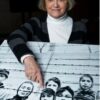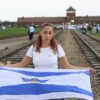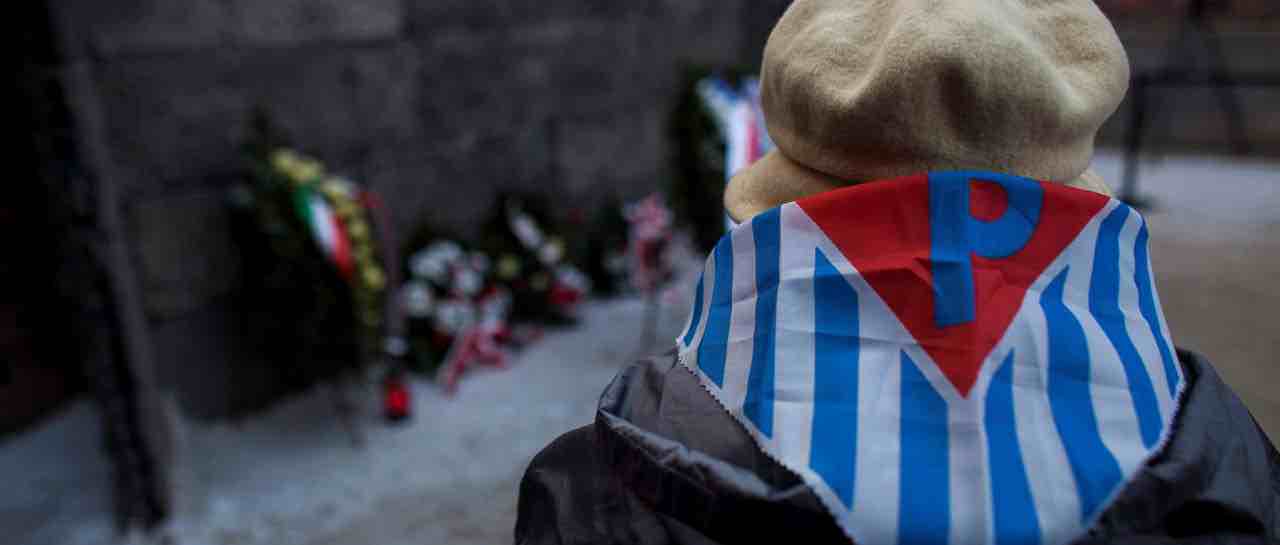
A survivor standing in front of the “death wall” in the Auschwitz-Birkenau, January 27, 2017. Agency Gazeta/Kuba Ociepa/via Reuters
The Holocaust is often told as the story of loss, quantified by concrete numbers, specific dates, sites of persecution and searing images that scorch our collective psyche. But to a group of survivors known as the “hidden children,” the Holocaust is far more diffuse and elusive.
It lurks in the shadows of the subconscious: the scent of a mother, the pitch black of a locked closet, a tap at the door – senses that torment well into adulthood and exist without context or the benefit of a full narrative.
It’s a story that unraveled years after liberation, weaving together fragmented childhoods with tattered family yarns, webs of secrets and gaping holes that cry out to be filled.
If survivors of camps and ghettos endeavored to forget their pasts, hidden children struggle to recuperate theirs, tirelessly searching for community, identity, to be recognized, to be found.
These last survivors of the Shoah, born in the mid- to late-1930s, were perhaps unwitting and silent witnesses. But last month, the Hidden Children Foundation celebrated its 25th anniversary at the New York offices of the Anti-Defamation League, an organization whose national director emeritus, Abraham H. Foxman, was saved by his Polish-Catholic nanny during the war. Stepping out of the shadows was daunting. “Silence was the only thing we could control,” he said in his keynote speech. “Until that first conference many of us weren’t able to acknowledge who we were or what we had been through.”
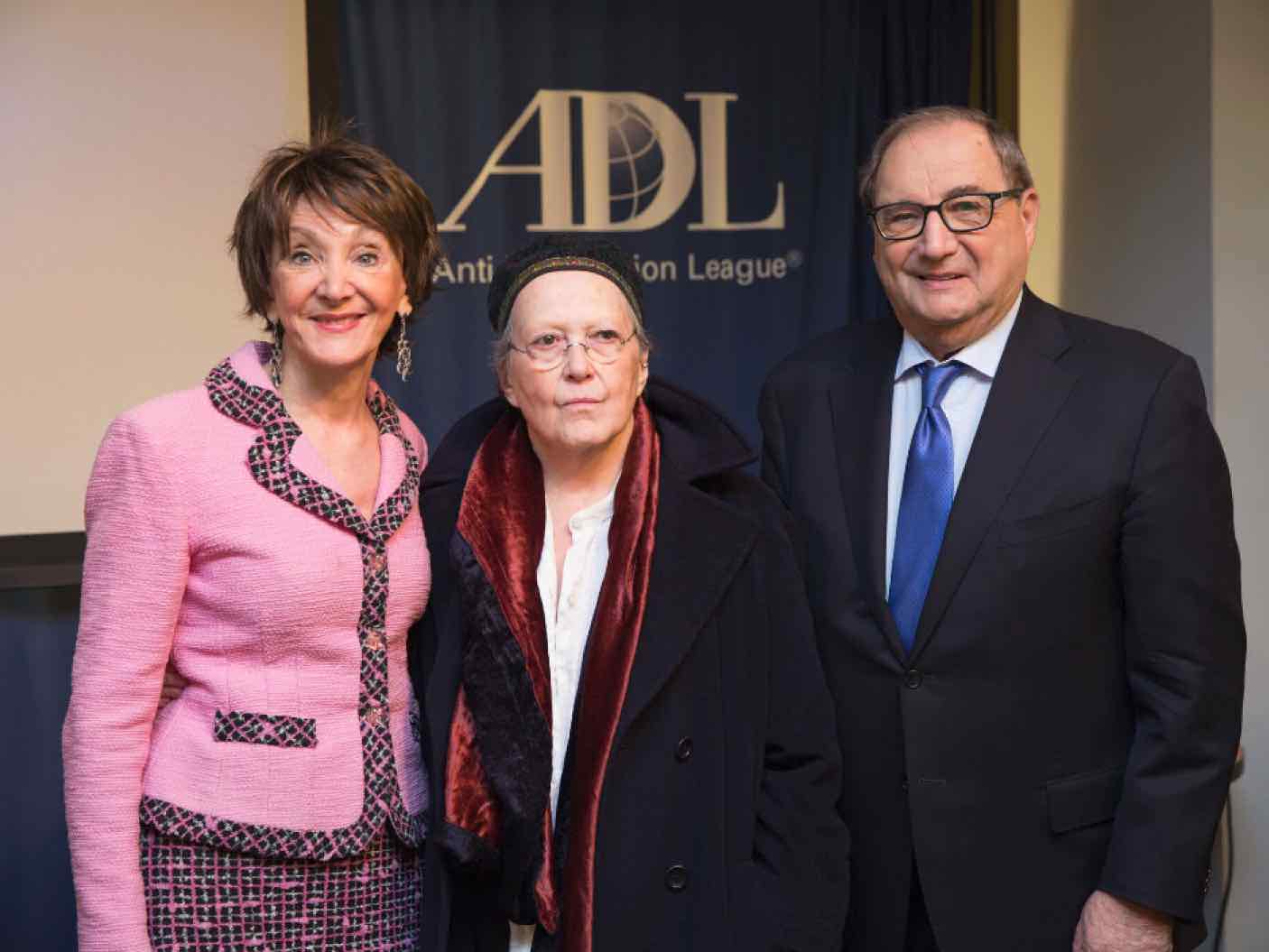
Eva Fogelman, Myriam Abramowicz and Abraham Foxman, founders of the Hidden Children Foundation at its 25th anniversary in December at ADL headquarters. Each was awarded for commitment to survivors. Jennifer Liseo
The timing of that first conference in 1991 also coincided with the downfall of Communism, unleashing a tidal wave of self-discovery in Eastern Europe. Suddenly hundreds of Poles began to search for their roots and embrace a faith that their parents or grandparents had closeted, sparking the Polish Jewish renaissance and further expanding our understanding of the Shoah and the toll it took on previously unacknowledged lives.
Their stories shift the Holocaust from a catalog of unimaginable loss to searches for memories and identities, for missing pieces that can fill deep personal voids.
“I spent my life in someone else’s shoes,” says Evelyne Haendel, 79. “But I wasn’t aware of it; only that they didn’t fit and were uncomfortable.”
Those other shoes belonged to Colette Vandor, the name given to Haendel by the Christian family that harbored her during the war. The moniker carried her from the age of 5 – when she arrived at the doorstep of neighbors in Liege, Belgium, with a doll in hand, nervously clutching her mother’s hand for the last time – to decades later when, at 40, she collapsed at work unable to stop crying or get off the floor, reeling from two failed marriages and the devastating realization that she wasn’t living in her own skin.
“It was really like having a split personality, but without the knowledge of being split,” she says. “I believed my own lies: that I was born to an English mother; that I was Christian. I kept a picture of my real mother, but I never looked at it. That would be admitting something about myself I wasn’t prepared to admit,” she says.
But after her “breakdown,” Haendel couldn’t stop looking at her old photographs. Holed up in her apartment for months, her business partner showed up one day with a therapist. “You can’t make an omelet without breaking eggs. It’s going to be OK,” she recalls the therapist saying.
With his help, she began picking up those eggshells, instead of tiptoeing around them, and discovered there was a term for her: hidden child.
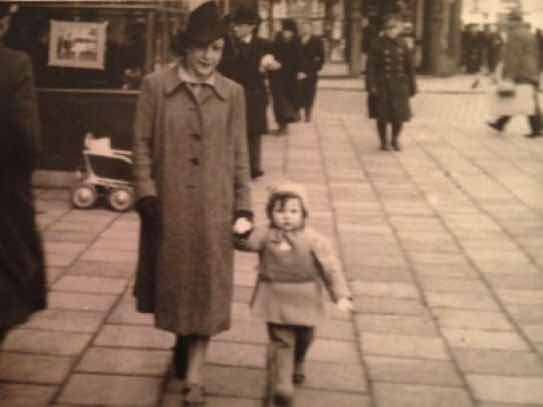
Evelyne Haendel with her mother in Antwerp, most likely in 1939. Photo courtesy of Evelyn Haendel
Filling the void
The term was officially recognized in May 1991, when 1,600 people from 28 countries converged on the New York Marriott Marquis Hotel to meet, discuss their experiences and fill in each other’s missing pieces.
Most bore the faintest recollections of youths spent in churches, trying to pass as good Catholics or being sequestered in homes whose occupants they couldn’t name. Some were men who remembered being told to dress as girls to avoid being checked for circumcision.
The event, called the First International Hidden Child Gathering, grew out of Myriam Abramowicz’ 1980 film “As If It Were Yesterday” (“Comme si c’était hier”) – a documentary about the rescue of over 4,000 children in Belgium during the Holocaust, one of whom had been Abramowicz’s mother.
“My mother kept all these black and white photos in a bag,” the filmmaker tells Haaretz. ”I was fascinated by them and made her tell me the stories behind each one, over and over again. At the time, there was no label for what she had endured. It was only after I was in the editing room with my footage and I had to caption it that I decided to call them ‘enfant caché,’ or hidden child.”
The photos revealed elements of her mother’s life that came to define the hidden child experience: that they had been doubly uprooted – first from their familial homes, and then from the homes of those who sheltered them during the war; that they had assumed false identities that left them with a shattered sense of self; that they often felt alone with their hidden pasts, shamed by this big secret that could mean the difference between life and death; and that they faced adulthood yearning for connection and clues to a nebulous past.
“Imagine what it feels like to not know your name or where you are from or what your birthday is,” says Rabbi Susan Schnur, a clinical psychologist and writer who covered the first hidden children gathering for Lilith magazine. “It cuts to your very core of being.”
She recalls messages placed on boards at that first conference that still haunt her to this day. One read: “Do you know who I am?”
“Validation is the cornerstone of resilience,” she says. “All it takes is one person to see you, to recognize you, to let you know you’re not crazy, that what you’ve endured is real, to make a profound difference on someone’s life. Clinically, we call it twinning, because you’re not alone and you don’t have to explain yourself; that other person knows how you feel. That’s what made that conference so amazing. These connections helped fill that emptiness they had carried their whole lives.”
Abramowicz recalls how vital the message boards were to this hitherto silent group.
“Most of these survivors had never spoken about their experiences because they weren’t sure of their circumstances, were still in hiding all these years later, and weren’t recognized as legitimate among Holocaust survivors because they were told they hadn’t suffered as much as survivors of camps and ghettos, and therefore [were] not entitled to reparations from the German government,” she says. “This conference gave them permission to express themselves, without having to excuse how their childhood was shaped. Just because they were in a farm, and someone else was in a camp, doesn’t make their story any less traumatic to them. In many ways, they had it worse because they didn’t know, but knew they were blank slates, tabula rasa – and not knowing prevented them from living authentic and whole lives.”
Haendel knew her parents had been killed, but didn’t want to know the details. It was only years later that she was able to face the facts and even visit Auschwitz, where they had been murdered. Only an aunt survived.
The memory of her aunt’s solo return still hurts.
“My aunt came back a frightening person,” says Haendel. “I felt guilty for years that I didn’t want to have anything to do with her. She reminded me of my mother, but she wasn’t her. And I must have reminded her of her daughter who was killed in Auschwitz. She had no affection for me, only bitterness.”
The aunt didn’t adopt Evelyne, even though often relatives did, removing hidden children from loving wartime homes and sometimes subjecting them to years of abuse, says clinical psychologist Eva Fogelman, who helped organize the first hidden children gathering.
“Those who were placed in convents or boarding homes were set free after the war, often orphaned and left to fend for themselves,” she explains. “They developed a real fear of abandonment, and coping strategies to survive such as maintaining a low profile and always having to be nice and good, since everything was conditional for them. Later in life, they never learned to advocate for themselves and never complained. They never wanted to be a burden, so they learned not to ask for anything.”
Though guilt characterizes many types of survivors, Fogelman says that with hidden children it’s often related to the sense they didn’t suffer enough, that they are imposters or that they’re somehow unworthy of love – a by-product of being placed in loveless homes.
“That guilt led to silence, which then prevented them from expressing any feelings at all,” she adds. “They could never cry and became numb for the rest of their lives. Many remained single or married men who would have been their father’s age, or were unable to sustain their marriages for more than a couple of years.”
That was certainly the case for Haendel, whose two marriages both ended after three years.
“I didn’t know what love was,” she says. “I was confused about who I was, afraid to be close to anyone because I didn’t know who I was and I didn’t want anyone to know.”
‘Constant fear’
Though some suffered from feeling like an imposter, that wasn’t the case for Rachelle Goldstein, codirector of the Hidden Child Foundation at the Anti-Defamation League. She was only 3 years old when she was placed in an orphanage.
“I was with my cousins and thought that’s what every kid does when they’re three,” she recounts. “I was treated well, and then after a while I was sent to a convent. Because I was the youngest, I was separated from everyone else. It was my first time all alone. The nuns were so mean: If I cried, they locked me in a closet. I remember being hungry and being told that if I wasn’t baptized, I’d go to hell. I begged them to baptize me, but they refused. I didn’t even know I was Jewish or what Jewish meant. I also thought my name was Lilly. I didn’t understand why they treated me differently than some of the other kids. I lived in constant fear.
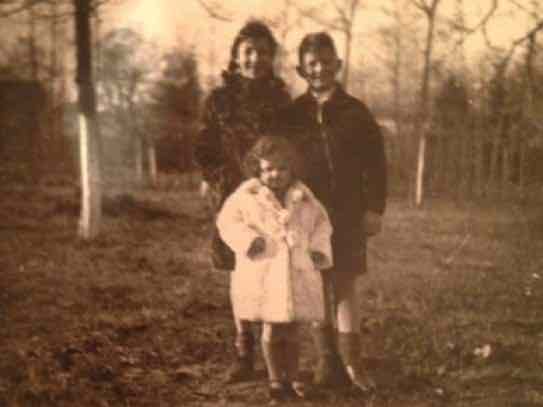
Evelyn Haendel (white coat) with her cousin Ursul, who later died in Auschwitz, and Ivar, the son of the people who hid her. Photo courtesy of Evelyn Haendel
“To this day, I can’t walk by a church,” she adds. “The scent of that incense fills me with panic. What kept me going was the thought of my mother holding me.”
When the war ended, Goldstein’s parents survived and came to claim her. But she didn’t recognize them. “I remembered my mother’s scent,” she says. “They took me home and I apparently said, ‘There are four walls here and not one has a cross.’ The nuns had also pinned an image of saints to my underwear, but my parents whisked it away. I asked. ‘Where are my saints? I need them for protection.’ And they put it back on. They were so smart to validate my feelings and fears. They let me talk about anything and always listened. I hate to think of what might have happened if they hadn’t.”
Her cousin wasn’t so lucky. The cousin’s mother, who by then had immigrated to the United States, didn’t want to hear of her daughter’s wartime traumas. She never allowed her to speak and remained a cold, distant figure in her life.
As a result, Goldstein says, her cousin spent her whole life wandering and searching for love, but never found it. She also didn’t go to college, even though she was bright. She never forgave her mother for abandoning her, Goldstein adds, becoming self-involved and narcissistic, frozen at the age she was when her life was interrupted.
Goldstein, on the other hand, met her husband as a teenager, newly transplanted to America. He was a lifeguard at a Catskills resort.
“He was so blond I didn’t think he was Jewish,” she recalls. “We began talking and I noticed an accent.” Before long, they realized they had both been rescued by Henri Reynders (better known as Father Bruno), a Belgian priest recognized as Righteous Among the Nations and responsible for saving more than 300 Jewish children.
No less Jewish
While many survivors of camps and ghettos are die-hard Zionists who believe the best response to the Holocaust is a strong Jewish state, many hidden children don’t have such allegiances. They’ve been rescued by “the other,” have had to integrate other cultures and religions into their identities from very young ages, and therefore prefer living in the Diaspora than in Israel. But that doesn’t mean they’re any less Jewish.
“My first memories are of being kindergarten age in Le Marais,” says Leon Lissek, who was born in Paris in 1936. “I remember the beautiful music in the Synagogue de la rue Pavée. My mother was a seamstress and sewed clothes for the nuns at a nearby nunnery, and so when the war broke out, they took us in, around early 1941. I was never baptized, but I had to learn all the hymns and I loved the music. To this day, I listen to Christmas mass. If my mother hadn’t survived to claim me, I might have been a priest.”
As fate had it, Lissek became a cantor just like his father. His daughter, Shira, is also a cantor, who got to know some of her father’s relatives in France – including those who never told their children they were Jewish.
“My dad is very positive, very grateful that he’s alive and very grateful to righteous gentiles,” she says. “He’s a humanitarian to the fullest and respects everyone, no matter their faith. He doesn’t put one person on a higher level than another because of religion or nationality. Everyone’s equal to him because he was dependent on the kindness of strangers and he treats strangers with utter kindness.”
Haendel says learning to accept her Jewish roots was an epiphany for her. But that doesn’t mean she’s ready to make aliyah.
“I love Israel, but I wouldn’t want to live there,” she says. “I don’t like isolationism or extremism from any side. And I don’t like the attitude that we are the best, we are pure, or that we are eternal victims. I don’t define myself that way. I’m still discovering who I am and trying to see people as they are, all over the world. I managed to go to Auschwitz, but I’m not sure I made peace there or ever could. But I don’t look at Germany the same way anymore. I’ve let go of that hate and that fear. The Shoah destroyed my family and it nearly killed me, but I am alive again. I am myself. I am no longer in hiding.”
Originally published HERE
